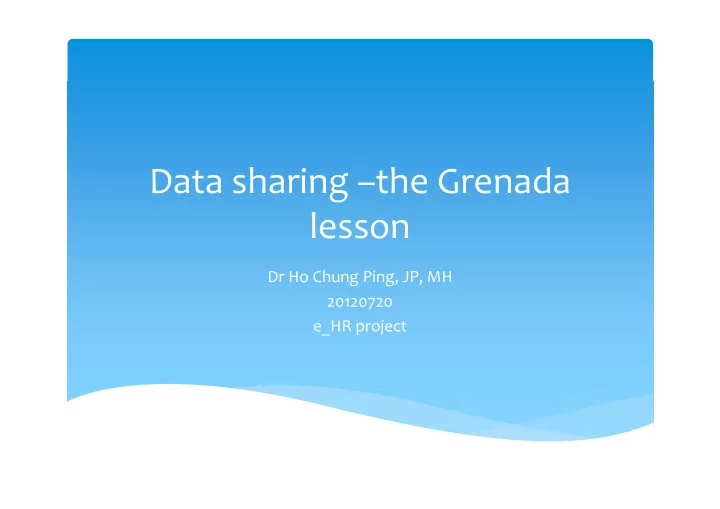

Data sharing –the Grenada g lesson Dr Ho Chung Ping, JP, MH 20120720 e_HR project
HIS in the USA HIS i th USA 1960 – Hospital information system using mainframe computers, mainly for billing 1970 – include labs and pharmacy services using mid ‐ range computers 1980 – include clinical information with client ‐ server 1980 i l de li i l i fo tio ith lie t e e computing 1983 – Grenada invasion 1983 Grenada invasion 1900 – Community Health information system (CHIS) or network (CHIN)
G Grenada d A country in the Caribbean sea Population 110,000 19 October, 1983 – a coup t t to topple the government l th g t 25 October,1983 The United States invaded United States invaded Grenada, Operation Urgent Fury
Th The military plan ‐‐ C2IR ilit l C IR C ommand – vice admiral Joseph Metcalf, III C ontrol – task force of 7500 (marines, SEALS, C ontrol task force of 7500 (marines, SEALS, Rangers), battle group USS Independence I ntelligence ‐ Grenada army – 1500 men g y 5 R econnaissance : tour guide map from a travel agency
B ttl Pl Battle Plan Marines attacked from the North Rangers landed on the Saline Point Airport in the south Radio ‐ communication managed by off ‐ shore d b ff h warships
R Results lt Rangers under heavy attack, radioed marines for support but failed but failed SEALS surrounded, saw helicopters above but communication failed communication failed SEAL called Fort Briggs using commercial phone Fort Briggs ordered Fort Briggs ordered helicopters to support via satellite
O Operation Urgent Fury ti U g t F Operation Urgent Fury is the military equivalent of a Japanese Kabuki dance, created by 3 ‐ 4 p y 3 choreographers, speaking different languages, all working independently of each other Congressional hearing – to revamp the strategy C4IR
C IR C4IR Command Control Computers Communication Intelligence – human, satellites, drone Reconnaissance – topographic maps Very successful in the Gulf wars
Traditional clinical practice C2IR T diti l li i l ti C IR Command – doctor Control – doctors order Control doctors order Intelligence: laboratory results Intelligence: laboratory results Reconnaissance – history and physical examination
Problems of Modern day medicine P bl f M d d di i More complicated cases More than one doctor More than one doctor Multiple specialties Battery of investigations Battery of investigations Communications between doctors vital, but Doctors more busy Doctors more busy Higher patient expectations
M d Modern medicine ‐ C4IR di i C IR C ommand and c ontrol, I, R C omputers – HA CMS 2.0 and the HKMA CMS 3.0 (TaoYuan and Wuhan version) ( ) C ommunication ‐ sharing of clinical and laboratory data, but data standardization is vital to have the link
Recommend
More recommend